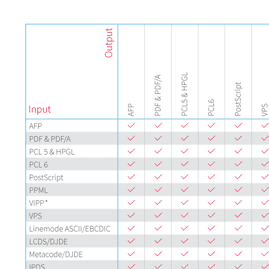
Convert PCL to any format
Converting documents to PCL is only the beginning of the Compart journey...
Converting PCL
As children, many of us played with a little toy one might get in a box of Cracker Jack. It was a little golf course with tiny tin balls and a few holes scattered about on a cardboard surface: the object was to get all the balls into a hole at the same time. The difficulty came from coordinating the movement of the various balls without knocking the ones already in a hole out. Oh, you could play for hours.
Now think of document composition. Similar, in that you create a number of X/Y axes and try to fit the data in those holes. The address data goes in one spot, the salutation in its spot, the body in another. Text, graphs, photos, marketing offers, regulatory compliance language all have an X/Y axis that must be filled.
Now think of post-composition manipulation or print stream engineering. You have a composed document but you need to add a barcode, or a variable data offering: one offer to the best customers, another to good customers, another for OK customers and a virtual lump of coal for the rest.
How do you engineer it without knocking the balls out of their safe spaces? Is that a game you want to play for hours? We’re not children any more. We have deadlines and KPI.
The answer, according to Compart, is to forget for a moment about the page composition and instead break the document down into objects or components. We call these things Docponents™ because they are the components that, taken together, comprise a document. Docponents™ don’t fall out of their holes when you try to fit another ball into another hole. They hold their integrity and are available for manipulation.
PCL to AFP (PCL2AFP)
It doesn’t matter if the data went in as PCL and came out as AFP (PCL2AFP). It doesn’t matter what the data format is, because the Docponents™ stay intact. If you want to convert PCL you can do so with ease. To transform PCL to another format is relatively simple because of the “any to any” format matrix you see here. So, for example--PCL2Postscript is eminently possible. Converting PCL to Postscript is as easy as running one finger along the top of the graphic until you find Postscript and then run another finger down the list until you find PCL. Voila, PCL to Postscript. It can be done.
The secret is…well maybe one should not be so hasty as to reveal the secret. I’ll do so, but give me a minute.
PCL to PostScript (PCL2PS) or PCL to PDF (PCL2PDF)
Whether you are transforming PCL to PostScript (PCL to PS; pcl2ps) or PCL to PDF (pcl2pdf) is not the issue. You can get these simple transforms for free online. But what those solutions lack that the Docponents™ method has, is data integrity and metadata integrity. And this is an important distinction.
Let’s take archiving as an example...in many companies around the world, electronic archiving is still split: incoming and outgoing documents are archived differently in separate departments. With different IT systems and metadata. The reason for this is the same thing that plagues many companies and organizations around the world: silo structures. When a document needs to be handled, management doesn’t know who owns the document: we don’t know what we already know. So we simply begin a new process. We’ve seen this a number of times. With EBPP for example: why NOT use the print process already in place to create an online version of the bill? Because no one thought of it. Billing crosses numerous siloes from IT to accounting to marketing. No one person owns it. So there is a duplicate effort.
So why maintain two archive interfaces and tie up valuable resources? Why not create a central instance for all the documents to be archived?
Whether you’re archiving input or output documents, the tasks are the same, namely generating, embedding and extracting metadata and storing the documents in read-only form, preferably in the recognized PDF/A standard.
And why run the same process twice? Not only is it expensive and time-consuming, it makes the document search more difficult.
Docponents™ allows for this: instead of tying up valuable resources maintaining two separate archive systems, there is one central archiving instance for securely archiving all incoming and outgoing documents. And the metadata is not rasterized, as happens so often when converting PCL2PDF or PCL2PDF/UA. The data is not smashed. It is available for use by the entire enterprise.
Therefore the ability to convert PCL to AFP (PCL2AFP), PCL to PostScript - PCL to PS (PCL2PS), or PCL to PDF(PCL2PDF) is available to your organization for inputting and outputting documents. The process has been done successfully over a long period of time by many customers and they always say the same thing: it just works. It works and it doesn’t stop working.
Reliability is one of our key value propositions. So contact us for the help you need to convert PCL.
Compart Matrix
A complete overview of all supported input and output formats is provided in the Compart Matrix. Compart software solutions enables highly complex, single pass operations with flexibility and reliability for high availability, high volume environments.



